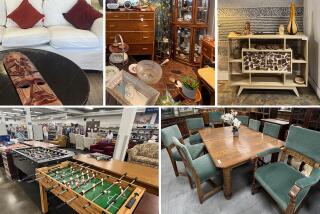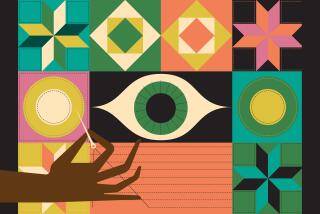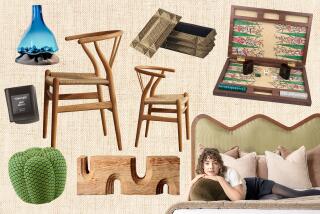When Radios, Television Sets Were Furniture
The living room in every middle-class home of the 1930s featured a radio. A large cabinet in the William-and-Mary revival style or a pseudo-Deco style was kept at one end of the room, surrounded by chairs and a sofa. The family would gather and listen to the latest shows.
When television was introduced in the 1940s, the rich bought the tiny-screen sets, put a large magnifying glass in front of the screen and invited friends over to view the wondrous new invention.
By the 1950s, the television became part of the furniture and was often hidden behind the doors of a special cabinet. The massive set had a dominant presence in the room. Eventually, the screens became larger and larger, and the cases were less important.
Today, some of the newest sets are so thin they can be hung on the wall like a picture. Collectors of electronic items want any that look different. Most TV sets looked like a box with a screen set in it. One set looked like a box with a screen perched in another box on top.
A favorite style was a box with a set-in screen, standing on four thin, tapered, very ‘50s-looking legs. A 1970s set that looked like an astronaut’s helmet was popular. But a few TVs featured strange geometric shapes and colors that were suited only to the most high-style rooms.
*
Question: When were Hudson Bay blankets first made? I’m looking for the kind with a few red, green and yellow stripes. Is there any way to date the blankets? I found a few used ones to put in my rustic bedroom.
*
Answer: The early Hudson Bay blankets were brought to the colonies to be used for trade in the 17th century. The Hudson Bay Co. had a design that was first used about 1740.
It included up to four thin black stripes that went a short distance across the blanket. There could also be wide decorative stripes on the same blanket. The stripes, or “points,” as they were called, indicated the trade value. Two stripes meant the blanket was worth two fine beaver pelts.
The earliest Hudson Bay blankets were made of solid colors with a wide band of a dark color at each end. White, light blue, green, dark blue and red blankets were made.
The white blanket with multicolor stripes was first made about 1820. It was called a “chief’s blanket” or “candy-striped blanket” and was often worn by American Indians as camouflage when hunting in the snow.
Standard sizes were used after 1882. The labels on the blankets are some indication of age. Each label has a coat of arms and the name of the company. The added words, “All genuine Hudson Bay Blankets bear this trademark,” were used before 1920. After that, the line became, “All genuine Hudson Bay Blankets bear this seal.” “Made in England” was added about 1920. “Laine,” the French word for “wool,” was added in the 1980s.
*
Q: When did they make the dolls representing Barbie’s mother and father?
*
A: Never. They have names, George and Margaret Roberts, but the dolls were never made.
*
Q: How can I tell if a piece of jewelry is made of Bakelite?
*
A: Touch the plastic with a red-hot needle in a very inconspicuous spot (you must own the piece before you can try this method). Bakelite will not melt. Other plastics will leave a small hole where the needle melts the plastic.
Bakelite pieces should not have mold lines. You can learn to recognize the smell of Bakelite when it is warm. Heat the piece in warm water or rub it briskly until it is warm. Your finger should smell like carbolic acid.
The trick that’s used the most is not always reliable. Put some Simichrome polish on a cloth and rub it on the back of the Bakelite piece. The pink Simichrome polish will turn amber-colored if it is Bakelite. Unfortunately, even if the piece is Bakelite, sometimes the polish remains pink.
*
Q: When did New Martinsville Glass work?
*
A: The New Martinsville Glass Manufacturing Co. worked from 1901 to 1944. It became the Viking Glass Co. in 1944.
*
Q: I have a pair of stylized birds that my grandmother owned in the 1940s. They look like herons. Each is 12 inches tall. One is marked “Brad Keeler” on the bottom. The other has the words “Clay Sketches.” Can you tell me about them?
*
A: Bradley Keeler worked in Los Angeles in the 1950s. Clay Sketches of Pasadena was started by Cy Peterson in 1943. They are best known for their bird figurines. California pottery of the ‘40s and ‘50s is now very popular with collectors. One of the birds could be worth $75.
For a listing of helpful books and publications, include a self-addressed, stamped (55 cents) envelope to Kovels, Los Angeles Times, King Features Syndicate, 235 E. 45th St., New York, NY 10017.
Current Prices
Current prices are recorded from antiques shows, flea markets, sales and auctions throughout the United States. Prices vary because of local economic conditions.
* Harker tidbit tray, Country Cousins pattern, ring handle, 10 inches, $30.
* Nettie Rosenstein earrings, pansy shape, enamel, gold-tone and topaz-colored stones, 3/4 inch, $55.
* True-Tone radio, fake wood case, metal, curved, waterfall style, Bakelite knobs, 1930s, $65.
* Planters Peanuts bank, Mr. Peanut, cast iron, 1970s, $120.
* Circular plane, Evans patent March 22, 1864, made by R.H. Mitchell and Co., Hudson, N.Y., $275.
* Steuben bowl, Large Sunflower, No. 8530, designed by Eric Hilton, 1986, 10 inches, $480.
* Tramp art pedestal box, dark-brown stain, deep-red paint, circular base, c. 1900, 17 1/2 by 13 3/4 inches, $850.
* Nutmeg grater, covered compartment, Jacobi & Jenkins, 1900, 5 inches, $900.
* Charles Eames for Herman Miller fiberglass shell armchairs, orange, swivel-mounted pedestal bases, set of 4, $1,150.
* Lone Ranger composition doll, with sheriff badge, original tag and clothing, felt hat, cast-iron pistol and mask, 1938, Bond Bread premium, 16 inches, $1,195.
More to Read
Inside the business of entertainment
The Wide Shot brings you news, analysis and insights on everything from streaming wars to production — and what it all means for the future.
You may occasionally receive promotional content from the Los Angeles Times.










